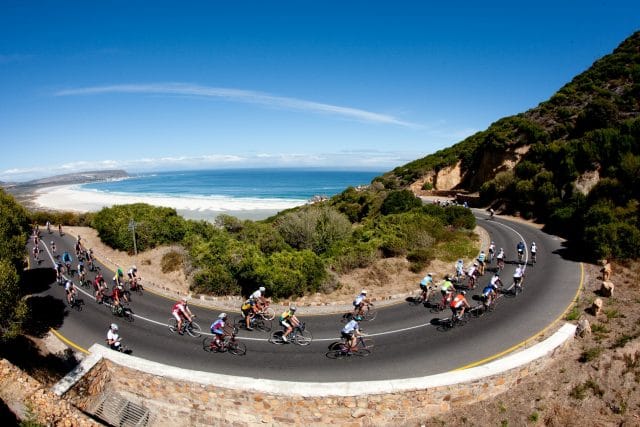How to Smash Every Climb at the CT Cycle Tour
Jarred Salzwedel, sports scientist and coach at Science To Sport, takes you through the Cape Town Cycle Tour’s ups and downs.
It’s easy to get caught out on the hills – and lose time. This is where you have to be smart, explains Salzwedel. “If you struggle with climbs, then a good strategy is to start at the front, and slide back slowly through the bunch.” Here, Salzwedel breaks down the Cycle Tour climbs.

Edinburgh Drive
“Edinburgh Drive is sharp but short. Place yourself in the first quarter of the group, and you’ll be over it before you know it.”
Smitswinkel
Salzwedel says Smitswinkel is the first real test of whether you’ve brought your climbing legs – it’s a long, gradual drag. “Sit near the front; and ride behind someone who has a smooth pedal stroke, and focus on that. Don’t move about on the bike, that’s just a waste of energy.”
Chapman’s Peak
You can divide this iconic section of the Cycle Tour into Little Chappies and Big Chappies, says Salzwedel. “One of the biggest Cycle Tour mistakes I’ve seen is at Little Chappies: when riders tackle the climb, they shift into the small chainring at the front too quickly – and that puts them at risk of dropping their chain. What happens is that when you shift down, the chain line is running at an angle; and then when you put too much pressure through the pedals, the chain drops. “I’d suggest that you power up in the big ring; but if that’s too tough, don’t destroy your legs. If you need to shift to an easier gear, then back off the power when you shift . You may lose a little momentum, but it’s better than dropping a chain. “The advantage of being in the big chainring is that when you crest Little Chappies, you’re ready to take on the fast section that takes you to the start of Big Chappies.” Don’t dig too deep on Big Chappes, though – there’s still a fair bit of the race to come.
Suikerbossie
If you’re going for a sub-3, Suikerbossie is a five-minute all-out effort. “Do your best to hang on to the group – because if you don’t stay with them when you get to the top, you will lose them (and your sub-3) for the fast, easy ride to the finish.” For sub-4 and sub-5 riders, it’s still a tough climb, because it comes when you already have almost 100 kays in your legs (but at 2km, it’s actually not that long). Let the cheering fans motivate you. Get into an even rhythm, and pace yourself to the top.
READ MORE ON: Cape Town Cycle Tour CTCT how to Skills

